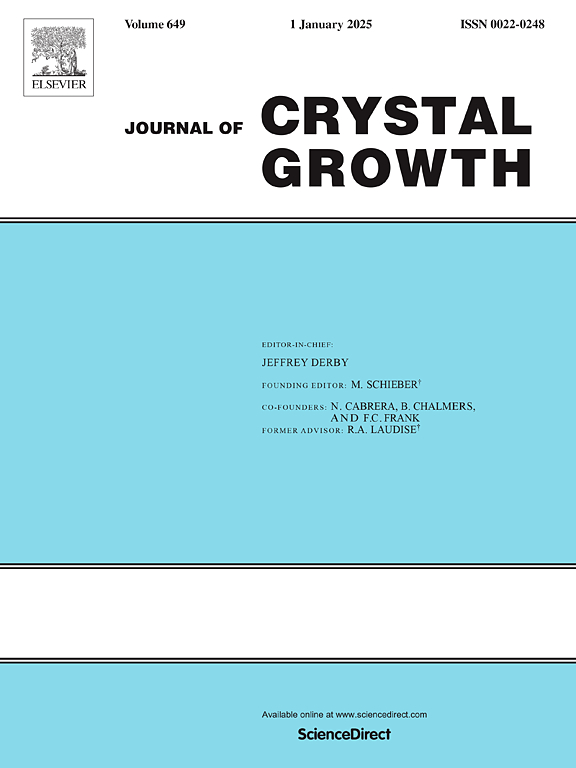脉冲时间控制对热原子层沉积(T-ALD)制备Ga2O3薄膜结构生长特性和光学性能的影响
IF 2
4区 材料科学
Q3 CRYSTALLOGRAPHY
引用次数: 0
摘要
氧化镓(Ga2O3)薄膜的合成主要利用臭氧(O3)或氧等离子体作为氧源。然而,H2O作为氧前驱体对Ga2O3薄膜性能的影响尚未得到广泛的研究。在这项研究中,我们采用以三甲基镓(TMG)和水(H2O)为前驱体的热原子层沉积(T-ALD)技术,系统地研究了450℃恒温下蓝宝石衬底上Ga2O3薄膜的生长特性。水脉冲持续时间在0.1到0.5秒之间变化。结果表明,当脉冲时间为0.1 ~ 0.3 s时,Ga2O3薄膜呈现α-相;随着水脉冲持续时间的增加,膜经历过渡到无定形结构,并伴随着明显的氧空位的形成。当脉冲持续时间为0.2 s时,膜的粗糙度达到0.531 nm,而当脉冲持续时间为0.3 s时,膜的带隙达到5.53 eV。在功率强度为224 μW/cm2的紫外光照射下,该探测器光电流为4.7 × 10−7 a,暗电流为4.2 × 10−9 a,最大通断比为112,响应度为0.6 mA/W。该器件在5 V偏置电压下的响应时间(τr)为0.08 s,衰减时间(τd)为5.20 s,并具有持久的光导电性(PPC)。本文章由计算机程序翻译,如有差异,请以英文原文为准。
Effect of pulse time control on the structural growth characteristics and optical properties of Ga2O3 thin films prepared by thermal atomic layer deposition (T-ALD)
The synthesis of gallium oxide (Ga2O3) thin films has predominantly utilized ozone (O3) or O2 plasma as oxygen sources. However, the impact of H2O as an oxygen precursor on the properties of Ga2O3 films has not been extensively explored. In this study, we employ thermal atomic layer deposition (T-ALD) with trimethylgallium (TMG) and water (H2O) as precursors to systematically investigate the growth characteristics of Ga2O3 films on sapphire substrates at a constant temperature of 450 °C. The H2O pulse duration is varied between 0.1 and 0.5 s. Our results reveal that the Ga2O3 films exhibit the α-phase when the H2O pulse duration ranges from 0.1 to 0.3 s. As the H2O pulse duration increases, the films undergo a transition to an amorphous structure, accompanied by the formation of significant oxygen vacancies. The maximum film roughness of 0.531 nm is observed at a pulse duration of 0.2 s, while the highest bandgap of 5.53 eV is achieved at a pulse duration of 0.3 s. Under ultraviolet illumination with a power intensity of 224 μW/cm2, the solar-blind ultraviolet detector demonstrates a photocurrent of 4.7 × 10−7 A, a dark current of 4.2 × 10−9 A, and a maximum on/off ratio of 112, with a responsivity of 0.6 mA/W. The device exhibits a response time (τr) of 0.08 s and a decay time (τd) of 5.20 s at a bias voltage of 5 V, along with persistent photoconductivity (PPC).
求助全文
通过发布文献求助,成功后即可免费获取论文全文。
去求助
来源期刊

Journal of Crystal Growth
化学-晶体学
CiteScore
3.60
自引率
11.10%
发文量
373
审稿时长
65 days
期刊介绍:
The journal offers a common reference and publication source for workers engaged in research on the experimental and theoretical aspects of crystal growth and its applications, e.g. in devices. Experimental and theoretical contributions are published in the following fields: theory of nucleation and growth, molecular kinetics and transport phenomena, crystallization in viscous media such as polymers and glasses; crystal growth of metals, minerals, semiconductors, superconductors, magnetics, inorganic, organic and biological substances in bulk or as thin films; molecular beam epitaxy, chemical vapor deposition, growth of III-V and II-VI and other semiconductors; characterization of single crystals by physical and chemical methods; apparatus, instrumentation and techniques for crystal growth, and purification methods; multilayer heterostructures and their characterisation with an emphasis on crystal growth and epitaxial aspects of electronic materials. A special feature of the journal is the periodic inclusion of proceedings of symposia and conferences on relevant aspects of crystal growth.
 求助内容:
求助内容: 应助结果提醒方式:
应助结果提醒方式:


